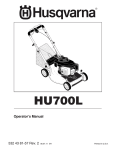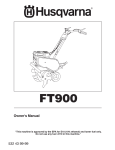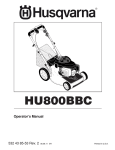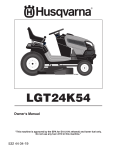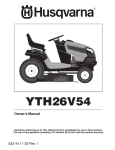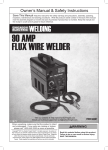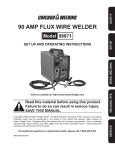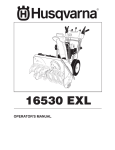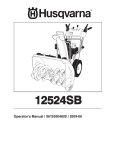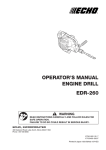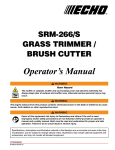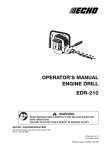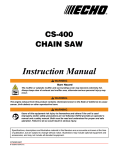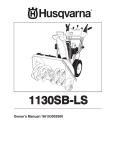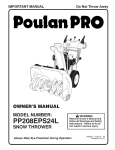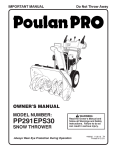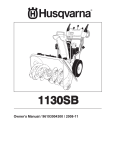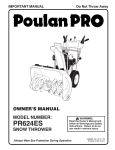Download Husqvarna 1827EXLT User's Manual
Transcript
Operator’s Manual
1827EXLT
Gasoline containing up to 10% ethanol (E10) is acceptable for use in this machine.
The use of any gasoline exceeding 10% ethanol (E10) will void the product warranty.
532 44 35-56
Please read the owner's manual carefully and make sure you
understand the instructions before using the machine.
English
IMPORTANT
Safe Operation Practices for Walk-Behind Snow Throwers
This snow thrower is capable of amputating hands and feet and throwing objects.
Failure to observe the following safety instructions could result in serious injury.
WARNING: Snow throwers have exposed rotating parts, which can cause
severe injury from contact, or from material thrown from the discharge chute.
Keep the area of operation clear of all
persons, small children and pets at all
times including startup.
Look for this symbol to point out important safety precautions. It means
CAUTION!!! BECOME ALERT!!! YOUR
SAFETY IS INVOLVED.
WARNING: Always disconnect spark
plug wire and place it where it cannot
contact plug in order to prevent accidental starting when setting up, transporting, adjusting or making repairs.
CAUTION: Muffler and other engine
parts become extremely hot during
operation and remain hot after engine
has stopped. To avoid severe burns on
contact, stay away from these areas.
WARNING: This snow thrower is for
use on sidewalks, driveways and other
ground level surfaces. Caution should
be exercised while using on sloping surfaces. Do not use snow thrower on
surfaces above ground level such as
roofs of residences, garages, porches
or other such structures or buildings.
WARNING: Engine exhaust, some of
its constituents, and certain vehicle
components contain or emit chemicals known to the State of California
to cause cancer and birth defects or
other reproductive harm.
Training
1. Read, understand and follow all instructions on the
machine and in the manual(s) before operating this
unit. Be thoroughly familiar with the controls and the
proper use of the equipment. Know how to stop the
unit and disengage the controls quickly.
2. Never allow children to operate the equipment. Never
allow adults to operate the equipment without proper
instruction.
3. Keep the area of operation clear of all persons, particularly small children.
4. Exercise caution to avoid slipping or falling, especially
when operating the snow thrower in reverse.
5.
6.
7.
Preparation
1. Thoroughly inspect the area where the equipment is
to be used and remove all doormats, sleds, boards,
wires, and other foreign objects.
2. Disengage all clutches and shift into neutral before
starting the engine (motor).
3. Do not operate the equipment without wearing adequate
winter garments. Avoid loose fitting clothing that can
get caught in moving parts. Wear footwear that will
improve footing on slippery surfaces.
4. Handle fuel with care; it is highly flammable
(a) Use an approved fuel container.
(b) Never add fuel to a running engine or hot engine.
(c) Fill fuel tank outdoors with extreme care. Never fill
fuel tank indoors.
(d) Never fill containers inside a vehicle or on a truck
or trailer bed with a plastic liner. Always place
containers on the ground, away from your vehicle,
before filling.
(e) When practical, remove gas-powered equipment
from the truck or trailer and refuel it on the ground.
If this is not possible, then refuel such equipment
on a trailer with a portable container, rather than
from a gasoline dispenser nozzle.
8.
(f) Keep the nozzle in contact with the rim of the fuel
tank or container opening at all times, until refueling
is complete. Do not use a nozzle lock-open device.
(g) Replace gasoline cap securely and wipe up spilled
fuel.
(h) If fuel is spilled on clothing, change clothing immediately.
Use extension cords and receptacles as specified by
the manufacturer for all units with electric drive motors
or electric starting motors.
Adjust the collector housing height to clear gravel or
crushed rock surface.
Never attempt to make any adjustments while the
engine (motor) is running (except when specifically
recommended by manufacturer).
Always wear safety glasses or eye shields during operation or while performing an adjustment or repair to
protect eyes from foreign objects that may be thrown
from the machine.
Operation
1. Do not put hands or feet near or under rotating parts.
Keep clear of the discharge opening at all times.
2. Exercise extreme caution when operating on or crossing gravel drives, walks, or roads. Stay alert for hidden
hazards or traffic.
3. After striking a foreign object, stop the engine (motor),
remove the wire from the spark plug, disconnect the
cord on electric motors, thoroughly inspect the snow
thrower for any damage, and repair the damage before
restarting and operating the snow thrower.
4. If the unit should start to vibrate abnormally, stop the
engine (motor) and check immediately for the cause.
Vibration is generally a warning of trouble.
5. Stop the engine (motor) whenever you leave the operating position, before unclogging the collector/impeller
housing or discharge chute, and when making any
repairs, adjustments or inspections.
2
Clearing a Clogged Discharge Chute
6. When cleaning, repairing or inspecting the snow thrower,
stop the engine and make certain the collector/impeller and all moving parts have stopped. Disconnect
the spark plug wire and keep the wire away from the
plug to prevent someone from accidentally starting the
engine.
7. Do not run the engine indoors, except when starting
the engine and for transporting the snow thrower in or
out of the building. Open the outside doors; exhaust
fumes are dangerous.
8. Exercise extreme caution when operating on slopes.
9. Never operate the snow thrower without proper guards,
and other safety protective devices in place and working.
10. Never direct the discharge toward people or areas
where property damage can occur. Keep children and
others away.
11. Do not overload the machine capacity by attempting
to clear snow at too fast a rate.
12. Never operate the machine at high transport speeds
on slippery surfaces. Look behind and use care when
operating in reverse.
13. Disengage power to the collector/impeller when snow
thrower is transported or not in use.
14. Use only attachments and accessories approved by
the manufacturer of the snow thrower (such as wheel
weights, counterweights, or cabs).
15. Never operate the snow thrower without good visibility
or light. Always be sure of your footing, and keep a firm
hold on the handles. Walk; never run.
16. Never touch a hot engine or muffler.
17. When using your snowthrower in for long periods of
time in deep snow, be aware of snow and ice build up
between the track components. This may cause a loss
of performance in the drive system.
Clean out snow and debris between tracks in regular
intervals.
Hand contact with the rotating impeller inside the discharge
chute is the most common cause of injury associated with
snow throwers. Never use your hand to clean out the discharge chute. To clear the chute:
1. SHUT THE ENGINE OFF!
2. Wait 10 seconds to be sure the impeller blades have
stopped rotating.
3. Always use a clean-out tool, not your hands.
Maintenance and Storage
1. Check shear bolts and other bolts at frequent intervals
for proper tightness to be sure the equipment is in safe
working condition.
2. Never store the machine with fuel in the fuel tank inside
a building where ignition sources are present such as
hot water heaters, space heaters, or clothes dryers.
Allow the engine to cool before storing in any enclosure.
3. Always refer to operator’s manual for important details
if the snow thrower is to be stored for an extended
period.
4. Maintain or replace safety and instruction labels, as
necessary.
5. Run the machine a few minutes after throwing snow
to prevent freeze-up of the collector/impeller.
3
CONGRATULATIONS on your purchase of a new snow
thrower. It has been designed, engineered and manufactured to give best possible dependability and performance.
Should you experience any problem you cannot easily
remedy, please contact your nearest authorized service
center. We have competent, well-trained technicians and
the proper tools to service or repair this unit.
Please read and retain this manual. The instructions will
enable you to assemble and maintain your snow thrower
properly. Always observe the “SAFETY RULES”.
PRODUCT SPECIFICATIONS
Gasoline Capacity
and Type:
Oil Type
(API SG–SL):
SERIAL NUMBER: ___________________________
0.5 Gallons (1,89 Liters)
Unleaded Regular only
SAE 30 (above 50°F)
SAE 5W-30 or 10W-30 (32° to 50°F)
SAE 5W-30 (below 32°F)
Oil Capacity:
38 Ounces (1,12 Liters)
Spark Plug:
Gap:
Champion F6RTC
0.030" (0,762 mm)
DATE OF PURCHASE: _______________________
THE MODEL AND SERIAL NUMBERS WILL BE FOUND
ON A DECAL ATTACHED TO THE REAR OF THE SNOW
THROWER HOUSING.
CUSTOMER RESPONSIBILITIES
•
•
YOU SHOULD RECORD BOTH SERIAL NUMBER AND
DATE OF PURCHASE AND KEEP IN A SAFE PLACE
FOR FUTURE REFERENCE.
•
Read and observe the safety rules.
Follow a regular schedule in maintaining, caring for
and using your snow thrower.
Follow the instructions under “Maintenance” and “Storage” sections of this owner’s manual.
TABLE OF CONTENTS
MAINTENANCE ..................................................... 16-17
SERVICE AND ADJUSTMENTS ........................... 18-20
STORAGE ................................................................... 21
TROUBLESHOOTING ................................................ 22
WARRANTY........................................................... 23-26
SAFETY RULES ........................................................ 2-3
PRODUCT SPECIFICATIONS ...................................... 4
CUSTOMER RESPONSIBILITIES................................ 4
ASSEMBLY / PRE-OPERATION ............................... 6-8
OPERATION ............................................................ 9-15
MAINTENANCE SCHEDULE ..................................... 16
4
PARTS PACKED SEPARATELY IN CARTON
(1) POWER CORD
(198563)
(1) MULTIWRENCH
(180684)
(3) RETAINER
SPRINGS
(169675)
(6) SHEAR BOLTS 1/4-20 x 1-3/4
(192090)
(2) FLAT WASHERS
(6) LOCKNUTS
1/4-20
(73800400)
(2) CARRIAGE BOLTS
3/8-16 x 2.25
SAFTEY
IGNITION KEY(S)
(443059)
(1) WASHER 3/8
(19131316)
(1) LOCKNUT 3/8
(73800600)
(2) HANDLE KNOBS
(1) LOCKNUT
5/16-18
(751153)
(1) CARRIAGE BOLT
5/16-18 x 5/8
(72250505)
(1) LOCKNUT
1/4-20
(191730)
5
(1) SHOULDER
BOLT 1/4-20
(179829)
(1) SPRING
(184505)
ASSEMBLY / PRE-OPERATION
Read these instructions and this manual in its entirety before you attempt to assemble or operate your new
snow thrower. Reading the entire manual will familiarize you with the unit, which will assist you in assembly,
operation and maintenance of the product.
Your new snow thrower has been assembled at the factory with the exception of those parts left unassembled for shipping
purposes. All parts such as nuts, washers, bolts, etc., necessary to complete the assembly have been placed in the parts
bag. To ensure safe and proper operation of your snow thrower, all parts and hardware you assemble must be tightened
securely. Use the correct tools as necessary to ensure proper tightness.
REMOVE SNOW THROWER FROM CARTON
SPEED
CONTROL
ROD
1. Remove all accessible loose parts and parts boxes
from carton.
2. Cut down all four corners of carton and lay panels flat.
3. Remove the two (2) screws securing the auger housing
to the pallet.
4. Remove all packing materials except plastic tie holding
speed control rod to lower handle.
5. Remove the two (2) plastic ties securing the upper
handle to the pallet.
6. Remove snow thrower from carton and check carton
thoroughly for additional loose parts.
PLASTIC TIE
UPPER
HANDLE
HANDLE
KNOB
LOWER
HANDLE
HOW TO SET UP YOUR SNOW THROWER
TOOL BOX (See Fig. 10)
A toolbox is provided on your snow thrower. The toolbox is
located on top of the belt cover. Store the extra shear bolts,
nuts and multi-wrench provided in parts bag in the toolbox.
NOTE: The multi-wrench may be used for assembly of the
chute rotator head to snow thrower and making adjustments
to the skid plates.
FIG. 1
UNFOLD UPPER HANDLE
1. Raise upper handle to the operating position and
tighten handle knobs securely. Additional carriage
bolts, washers and handle knobs are in bag of parts.
Use to secure upper handle to lower handle. Install
in lower holes in handles.
SPEED CONTROL ROD
RETAINER
SPRING
INSTALL SPEED CONTROL ROD (See Figs. 1 and 2)
1. Remove plastic tie securing rod to lower handle.
2. Insert rod into speed control bracket and secure with
retainer spring.
SPEED
CONTROL
BRACKET
FIG. 2
6
SPEED
CONTROL
LEVER
ASSEMBLY / PRE-OPERATION
INSTALL AUGER CONTROL ROD (See Figs. 5 and 6)
1. Retrieve vinyl sleeve and spring from bag of parts and
retrieve the auger control rod from carton chute tray.
Slide straight rod end through the small hole in the
vinyl sleeve. Hook spring in hole in rod end.
2. Hook end of spring into control arm with loop opening
up as shown. (See Fig. 5)
3. With top end of rod positioned under right side of control
panel, push down on rod and insert end of rod into hole
in auger control bracket. Secure with retainer spring.
INSTALL TRACTION DRIVE CONTROL ROD
(See Figs. 3 and 4)
The traction drive control rod is installed on the snow
thrower.
1. Remove plastic tie securing rod to lower handle.
2. With top end of rod positioned under left side of control
panel, push rod down and insert top end of rod into hole
in drive control bracket. Secure with retainer spring.
PLASTIC TIE
TRACTION DRIVE
CONTROL ROD
AUGER
CONTROL
ROD
VINYL
SLEEVE
CONTROL
ARM
VINYL
SLEEVE
LOOP
OPENING
UP
FIG. 5
FIG. 3
AUGER CONTROL ROD
TRACTION DRIVE
CONTROL LEVER
RETAINER
SPRING
RETAINER
SPRING
AUGER
CONTROL
LEVER
TRACTION
DRIVE
CONTROL
ROD
AUGER
CONTROL
BRACKET
DRIVE
CONTROL
BRACKET
FIG. 6
FIG. 4
7
ASSEMBLY / PRE-OPERATION
INSTALL DISCHARGE CHUTE / CHUTE ROTATOR
HEAD (See Fig. 7)
NOTE: The multi-wrench provided in your parts bag may
be used to install the chute rotator head.
1. Place discharge chute assembly on top of chute base
with discharge opening toward front of snow thrower.
2. Position chute rotator head over chute bracket. If necessary, rotate chute assembly to align square and pin on underside of chute rotator head with holes in chute bracket.
3. With chute rotator head and chute bracket aligned,
position chute rotator head on pin and threaded stud
of mounting bracket.
4. Install 3/8 washer and locknut on threaded stud and
tighten securely.
CHUTE
ROTATOR
HEAD
INSTALL CHUTE DEFLECTOR REMOTE CONTROL
(See Figs. 8 and 9)
1. Install remote cable bracket to discharge chute with
5/16-18 carriage bolt and 5/16-18 locknut as shown.
Tighten securely.
2. Install remote cable eyelet to chute deflector with
1/4-20 shoulder bolt and 1/4-20 locknut as shown. Tighten nut securely. Eyelet will be loose on shoulder bolt.
3. Install spring hooks between hex nuts on chute rotater
head and into hole in chute deflector as shown.
SPRING
1/4-20
SHOULDER
BOLT
3/8 LOCKNUT
HOOK
BETWEEN
HEX NUTS
ON CHUTE
ROTATER
HEAD
1/4-20
LOCKNUT
3/8 WASHER
5/16-18
CARRIAGE
BOLT
CABLE
EYELET
REMOTE
CABLE
BRACKET
PIN
5/16-18
LOCKNUT
THREADED
STUD
FIG. 8
CHUTE
BRACKET
ALIGN BEFORE
TIGHTENING LOCKNUT
CHUTE
DEFLECTOR
ROTATOR HEAD
MOUNTING
BRACKET
FIG. 7
CHUTE DEFLECTOR
CONTROL LEVER
FIG. 9
8
OPERATION
KNOW YOUR SNOW THROWER
READ THIS OWNER'S MANUAL AND ALL SAFETY RULES BEFORE OPERATING YOUR SNOW THROWER. Compare
the illustrations with your snow thrower to familiarize yourself with the location of various controls and adjustments. Save
this manual for future reference.
These symbols may appear on your snow thrower or in literature supplied with the product. Learn and understand
their meaning.
PRIMER
DANGER
OR WARNING
FORWARD
REVERSE
READ AND FOLLOW ALL SAFETY INFORMATION
AND INSTRUCTIONS BEFORE USE OF THIS PRODUCT.
KEEP THESE INSTRUCTIONS FOR FUTURE REFERENCE.
IGNITION KEY.
INSERT TO START
AND RUN,
PULL OUT TO STOP.
DISENGAGED
ENGAGED
SNOW
DISCHARGE
TRACTION
DRIVE CONTROL
9
OPERATION
MUFFLER
ELECTRIC
START
BUTTON
GASOLINE
FILLER CAP
AUGER
CONTROL
LEVER
POWER
CORD
PLUG
DISCHARGE CHUTE CONTROL LEVER
DRIVE SPEED
DEFLECTOR TRACTION
CONTROL LEVER
REMOTE
DRIVE
CONTROL LEVER CONTROL
LEVER
CHOKE
CONTROL
CHUTE
DEFLECTOR
SAFETY
IGNITION
KEY
LH TURN
TRIGGER
ON / OFF
SWITCH
PRIMER
LIGHT
FUEL SHUT-OFF VALVE
RECOIL (AUXILIARY) STARTER HANDLE
HANDLE
KNOB
CLEAN-OUT TOOL
NOTE: ITEMS ABOVE
ARE SHOWN IN
THEIR TYPICAL
LOCATION ON THE
ENGINE. ACTUAL
LOCATION MAY VARY
WITH THE ENGINE
ON YOUR UNIT.
MUFFLER
DISCHARGE
CHUTE
TOOLBOX
DRIFT
CUTTER
SKID PLATE
AUGERS
FIG. 10
MEETS A.N.S.I. SAFETY REQUIREMENTS
Our snow throwers conform to the standards of the American National Standards Institute.
Toolbox - used to store spare shear bolts, locknuts and
wrench.
Freewheel control – disengages transmission for pushing
the snowthrower with the engine off.
Safety ignition key - must be inserted for the engine to
start and run. Remove when snow thrower is not in use.
Electric start button - used for starting the engine.
Recoil (auxiliary) starter handle - used for starting engine.
Primer - pumps additional fuel from the carburetor to the
cylinder for use when starting a cold engine.
Choke Control - used for starting a cold engine.
ON / OFF switch - used to STOP the engine.
LH and RH turn triggers - used to steer the snow thrower.
Drive speed control lever - used to select forward or
reverse motion and speed of snow thrower.
Traction drive control lever - used to engage power-propelled forward or reverse motion of snow thrower.
Auger control lever - used to engage auger motion (throw
snow).
Discharge chute control lever - used to change the direction the snow is thrown.
Deflector remote control lever - used to change the
distance the snow is thrown.
Skid plate - used to adjust height of scraper bar from the
ground.
Drift cutter - used to cut through deep snowdrifts.
10
OPERATION
TRANSPORT AND HEIGHT ADJUSTMENT OF
SNOW THROWER
To operate the height adjust mechanism, using your
foot, push down on the pedal, tilt the unit to align
the pins with the selected height position and slowly
release foot pressure until the pins are seated in the
desired height setting.
TO TRANSPORT (See Figs. 11 & 12)
When transporting your snowthrower, be sure to disengage the transmission by placing freewheel control into
FREEWHEEL position (See Fig. 11) and height adjustment
locator into TRANSPORT MODE position (See Fig. 12).
• Pull freewheel control out to FREEWHEEL position.
• Set height adjustment into TRANSPORT MODE.
• To reengage transmission, push control back in.
FREEWHEEL
CONTROL
OIL EXPANSION
TANK
FREEWHEEL POSITION
PEDAL
FIG. 13
TRANSMISSION ENGAGED
FIG. 11
IMPORTANT: Your model snow thrower is equipped
with an oil expansion tank attached to the hydrostatic transmission (see fig. 13). As you run your snow
thrower, the oil level will rise in this tank as the oil
heats up and recess as the oil cools. This is normal
operation. You do not need to add oil to this tank as
part of regular maintenance.
SET HEIGHT ADJUSTMENT (See Figs. 12 & 13)
Your snow thrower is equipped with a foot controlled height
adjustment mechanism (See Fig. 13).
There are four height positions for operation (See Fig. 12)
1. PACKED SNOW
2. NORMAL OPERATION
3. TRANSPORT
4. FLOAT
The operation of any snow thrower can result
in foreign objects thrown into the eyes, which
can result in severe eye damage. Always wear
safety glasses or eye shields while operating
your snow thrower or performing any adjustments or repairs. We recommend standard safety glasses
or a wide vision safety mask worn over spectacles.
HOW TO USE YOUR SNOW THROWER
Know how to operate all controls before adding fuel or
attempting to start the engine.
STOPPING
TRACTION DRIVE
• Release traction drive control lever to stop the forward
or reverse movement of the snow thrower.
AUGER
• Release the auger control lever to stop throwing snow.
ENGINE
1. Move ON / OFF switch to “OFF” position.
2. Remove (do not turn) safety ignition key to prevent
unauthorized use.
NOTE: Never use choke to stop engine.
FIG. 12
11
OPERATION
TO USE FUEL SHUT-OFF VALVE (See Fig. 14)
The fuel shut-off valve is located beneath the fuel tank on
the engine. Always operate the snow thrower with the fuel
shut-off valve in the OPEN position.
•
Press downward on chute deflector control lever and
move lever forward to lower the deflector and decrease
the distance. Move lever back to raise the deflector
and increase the distance. Be sure lever springs back
and locks into desired position.
DISCHARGE CHUTE
CONTROL LEVER
OFF
OPEN
FIG. 14
TO USE CHOKE CONTROL (See Fig. 15)
The choke control is located on the engine. Use the choke
control whenever you are starting a cold engine. Do not
use to start a warm engine.
• To engage choke, rotate lever to “FULL” position.
CHUTE DEFLECTOR
REMOTE CONTROL LEVER
FIG. 16
TO THROW SNOW (See Fig. 17)
The auger rotation is controlled by the auger control lever
located on the right side handle.
• Squeeze auger control lever to handle to engage the
auger and throw snow.
• Release the auger control lever to stop throwing snow.
AUGER
CONTROL
LEVER
FIG. 15
TO CONTROL SNOW DISCHARGE (See Fig. 16)
WARNING: Snow throwers have exposed rotating parts, which can cause
severe injury from contact, or from material thrown from the discharge chute.
Keep the area of operation clear of all
persons, small children and pets at all
times including startup.
FIG. 17
USING THE CLEAN-OUT TOOL (See Fig. 18)
In certain snow conditions, the discharge chute may become clogged with ice and snow. Use the clean-out tool
to dislodge this blockage.
When cleaning, repairing, or inspecting, make
certain all controls are disengaged and the auger/impeller and all moving parts have stopped.
Disconnect the spark plug wire and keep the
wire away from the spark plug to prevent accidental starting.
WARNING: If the discharge chute or auger become clogged, shut-off engine
and wait for all moving parts to stop. Use
the clean-out tool, NOT YOUR HANDS,
to unclog the chute and/or auger.
The DIRECTION in which snow is to be thrown is controlled
by the discharge chute control lever.
• To change the discharge chute position, press downward
on discharge chute control lever and move lever left
or right until chute is in desired position. Be sure lever
springs back and locks into desired position.
The DISTANCE that snow is thrown is controlled by the
position of the chute deflector. Set the deflector low to
throw snow a short distance; set the deflector higher to
throw snow farther.
•
•
Release the auger control lever and shut off the engine.
Remove the clean-out tool from it's mounting clip. Grasp
the tool firmly by the handle and push and twist the tool
into the discharge chute to dislodge the blockage.
After the packed snow has been dislodged, return the cleanout tool to it's mounting clip by pushing it into the clip.
• Make sure the discharge chute is pointed in a safe direction (no vehicles, buildings, people, or other objects are
in the direction of discharge) before restarting engine.
• Restart the engine, then squeeze the auger control
lever to the handle to clear snow from the auger hous12
ing and the discharge chute.
OPERATION
POWER STEERING OPERATION (See Fig. 20)
Steering triggers are used to assist in steering your snow
thrower. The triggers are located on the underside of each
handle. When a trigger is squeezed, it disengages the track
drive on that side of snow thrower and allows it to turn in
that direction.
• To turn left – squeeze left side trigger.
• To turn right – squeeze right side trigger.
DISCHARGE
CHUTE
CLEAN-OUT
TOOL
MOUNTING
CLIP
LH TURN
TRIGGER
RH TURN
TRIGGER
FIG. 18
TO MOVE FORWARD AND BACKWARD (See Fig. 19)
SELF-PROPELLING, forward and reverse movement of
the snow thrower, is controlled by the traction drive control
lever located on the left side handle.
• Squeeze traction drive control lever to handle to engage
the drive system.
• Release traction drive control lever to stop the forward
or reverse movement of the snow thrower.
SPEED and DIRECTION are controlled by the drive speed
control lever.
• Move speed control lever to desired position AFTER
engaging the traction drive control lever.
FIG. 20
TO ADJUST SKID PLATES (See Fig. 21)
NOTE: The wrench provided in your parts bag may be
used to adjust the skid plates.
Skid plates are located on each side of the auger housing
and adjust the clearance between the scraper bar and the
ground surface. Adjust skid plates evenly to proper height
for current surface conditions. For removal of snow in
normal conditions, such as a paved driveway or sidewalk,
place skid plates in the highest position (lowest scraper
clearance) to give a 1/8" clearance between the scraper
bar and the ground. Use a middle position if the surface
to be cleared is uneven.
NOTE: It is not recommended to operate the snow thrower
over gravel or rocky surfaces. Objects such as gravel, rocks
or other debris, can easily be picked up and thrown by the
impeller, which can cause serious personal injury, property
damage or damage to the snow thrower.
• If snow thrower must be operated over gravel surface,
use extra caution and be sure skid plates are adjusted
to lowest (highest scraper clearance) position.
1. Shut off engine and wait for all moving parts to stop.
2. Adjust skid plates by loosening the hex nuts, then
moving skid plate to desired position. Be sure both
plates are adjusted evenly. Tighten securely.
CAUTION: Do not move speed control lever
unless engine is running. Damage to the snow
thrower can result.
•
Slower speeds are for heavier snow and faster speeds
are for light snow and transporting the snow thrower.
It is recommended that you use a slower speed until
you are familiar with the operation of the snow thrower.
NOTE: When both traction drive and auger control levers
are engaged, the traction drive control lever will lock the
auger control lever in the engaged position. This will allow
you to release your right hand from the handle and adjust
the discharge chute direction without interrupting the snow
throwing process.
SCRAPER BAR (See Fig. 21)
The scraper bar is not adjustable, but is reversible. After
considerable use it may become worn. When it has worn
almost to the edge of the housing, it can be reversed,
providing additional service before requiring replacement.
Replace a damaged or worn scraper bar.
TRACTION DRIVE
CONTROL LEVER
HIGH POSITION
(LOW GROUND
CLEARANCE)
HEX
NUTS
AUGER
HOUSING
LOW POSITION
(HIGH GROUND
CLEARANCE)
DRIVE SPEED
CONTROL LEVER
SCRAPER
BAR
SKID PLATE
FIG. 19
13
FIG. 21
OPERATION
TO USE DRIFT CUTTERS (See Fig. 22)
Use the drift cutters to cut through deep snowdrifts that
are higher than the front of the snow thrower.
• Loosen adjustment nuts enough to allow drift cutter to
be raised to highest position and tighten nuts securely.
Repeat for opposite side of snow thrower.
• When not using drift cutters, loosen adjustment nuts,
lower to storage position and tighten nuts securely.
RECOIL (AUXILIARY)
STARTER HANDLE
ON / OFF
SWITCH
GASOLINE
FILLER CAP
ENGINE OIL FILL
CAP / DIPSTICK
CHOKE
CONTROL
STARTER
BUTTON
AUGER
HOUSING
STORAGE
POSITION
DRIFT
CUTTER
SAFETY
IGNITION
KEY
PRIMER
ADJUSTMENT NUTS
POWER
CORD
PLUG
FUEL SHUT-OFF VALVE
FIG. 22
NOTE: ALL ITEMS ARE SHOWN IN THEIR TYPICAL LOCATION.
ACTUAL LOCATION MAY VARY WITH ENGINE ON YOUR UNIT.
BEFORE STARTING THE ENGINE
FIG. 23
CHECK ENGINE OIL LEVEL (See Fig. 23)
The engine on your snow thrower has been shipped from
the factory already filled with oil.
1. Check engine oil with snow thrower on level ground.
2. Remove oil fill cap/dipstick and wipe clean, reinsert
the dipstick and screw tight, wait for a few seconds,
remove and read oil level. If necessary, add oil until
“FULL” mark on dipstick is reached. Do not overfill.
• To change engine oil, see “TO CHANGE ENGINE OIL”
in the Maintenance section of this manual.
TO START ENGINE
• Be sure fuel shut-off valve is in the “OPEN” position.
Your snow thrower engine is equipped with both a 120 Volt
A.C. electric starter and a recoil starter. The electric starter
is equipped with a three-wire power cord and plug and is
designed to operate on 120 Volt A.C. household current.
• Be sure your house is a 120 Volt A.C. three-wire
grounded system. If you are uncertain, consult a
licensed electrician.
WARNING: Do not use the electric
starter if your house is not a 120 Volt
A.C. three-wire grounded system. Serious personal injury or damage to your
snow thrower could result.
ADD GASOLINE (See Fig. 23)
• Fill fuel tank to bottom of tank filler neck. Do not overfill. Use fresh, clean, regular unleaded gasoline with a
minimum of 87 octane. Do not mix oil with gasoline.
Purchase fuel in quantities that can be used within 30
days to assure fuel freshness.
COLD START - ELECTRIC STARTER
1. Insert safety ignition key (tied to recoil start cord) into
ignition slot until it clicks. DO NOT turn the key. Keep
the extra safety ignition key in a safe place.
2. Place ON / OFF switch in “ON” position.
3. Move choke control to “FULL” position.
4. Connect the power cord to the engine.
5. Plug the other end of the power cord into a three-hole
grounded 120 Volt A.C. receptacle.
NOTE: Do not use primer when starting engine with the
electric starter.
6. Push starter button until engine starts.
IMPORTANT: Do not crank engine more than five continuous seconds between each time you try to start. Wait 5 to
10 seconds between each attempt.
7. When the engine starts, release the starter button and
slowly move the choke control to the “OFF” position.
WARNING: Wipe off any spilled oil or
fuel. Do not store, spill or use gasoline
near an open flame.
CAUTION: Alcohol blended fuels (called gasohol or using ethanol or methanol) can attract
moisture which leads to separation and formation of acids during storage. Acidic gas can
damage the fuel system of an engine while in
storage. To avoid engine problems, the fuel
system should be emptied before storage of
30 days or longer. Empty the gas tank, start
the engine and let it run until the fuel lines
and carburetor are empty. Use fresh fuel next
season. See Storage Instructions for additional
information. Never use engine or carburetor
cleaner products in the fuel tank or permanent
damage may occur.
14
OPERATION
8. Disconnect the power cord from the receptacle first,
then from the engine.
Allow the engine to warm up for a few minutes. Engine will
not develop full power until it has reached normal operating temperature.
WARM START - ELECTRIC STARTER
Follow the steps above, keeping the choke control in the
“OFF” position.
COLD START - RECOIL STARTER
1. Insert safety ignition key (tied to recoil start cord) into
ignition slot until it clicks. DO NOT turn the key. Keep
the extra safety ignition key in a safe place.
2. Place ON / OFF switch in “ON” position.
3. Rotate choke control to “FULL” position.
4. Push the primer four (4) times if the temperature is
below 15°F, or two (2) times if temperature is between
15° and 50°F. If temperature is above 50°F, priming is
not necessary.
NOTE: Over priming may cause flooding, preventing the
engine from starting. If you do flood the engine, wait a few
minutes before attempting to start and DO NOT push the
primer.
5. Pull recoil starter handle quickly. Do not allow starter
rope to snap back.
6. When the engine starts, release the recoil starter handle
and slowly move the choke control to the “OFF” position.
Allow the engine to warm up for a few minutes. Engine will
not develop full power until it has reached normal operating temperature.
WARM START - RECOIL STARTER
Follow the steps above, keeping the choke in the “OFF”
position. DO NOT push the primer.
SNOW THROWING TIPS
•
•
•
•
•
•
•
•
•
•
Go slower in deep, freezing or heavy wet snow. Use
the drive speed control, NOT the ON / OFF switch, to
adjust speed.
It is easier and more efficient to remove snow immediately after it falls.
The best time to remove snow is the early morning.
At this time the snow is usually dry and has not been
exposed to the direct sun and warming temperatures.
Slightly overlap each successive path to ensure all
snow will be removed.
Throw snow downwind whenever possible.
Adjust the skid plates to proper height for current snow
conditions. See “TO ADJUST SKID PLATES” in this
section of this manual.
For extremely heavy snow, reduce the width of snow
removal by overlapping previous path and moving
slowly.
Keep engine clean and clear of snow during use. This
will help air flow and extend engine life.
After snow-throwing is completed, allow engine to run
for a few minutes to melt snow and ice off the engine.
Clean the entire snow thrower thoroughly after each
use and wipe dry so it is ready for next use.
WARNING: Do not operate snow
thrower if weather conditions impair
visibility. Throwing snow during a
heavy, windy snowstorm can blind you
and be hazardous to the safe operation
of the snow thrower.
BEFORE STOPPING
Run the engine for a few minutes to help dry off any moisture on the engine.
IF RECOIL STARTER HAS FROZEN
If the recoil starter has frozen and will not turn the engine,
proceed as follows:
1. Grasp the recoil starter handle and slowly pull as much
rope out of the starter as possible.
2. Release the recoil starter handle and let it snap back
against the starter.
If the engine still fails to start, repeat the above steps or
use the electric starter.
15
MAINTENANCE
LUBRICATION CHART
GENERAL RECOMMENDATIONS
The warranty on this snow thrower does not cover items
that have been subjected to operator abuse or negligence.
To receive full value from the warranty, operator must
maintain snow thrower as instructed in this manual. Some
adjustments will need to be made periodically to properly
maintain your snow thrower.
All adjustments in the Service and Adjustments section of
this manual should be checked at least once each season.
• Once a year, you should replace the spark plug and
check belts for wear. A new spark plug will help your
engine run better and last longer.
• Follow the maintenance schedule in this manual.
NOTE: Use only Original Equipment Manufacturer (OEM)
parts to service this unit. Failure to do so can cause the unit
to malfunction and pose a risk of injury to the operator.
➀ SAE 30 Motor Oil
➁ See “ENGINE” in
Maintenance section
➀ Pivot points
➁ Engine oil
BEFORE EACH USE
1. Check engine oil level.
2. Check for loose fasteners.
3. Check controls to be sure they are functioning properly.
LUBRICATION
Keep your snow thrower well lubricated
(See “LUBRICATION CHART”).
16
MAINTENANCE
SNOW THROWER
TO CHANGE ENGINE OIL
Determine temperature range anticipated before next oil
change. All oil must meet API service classification SG–SL.
• Be sure snow thrower is on level surface.
• Oil will drain more freely when warm.
• Catch oil in a suitable container.
NOTE: The left side track may be removed from snow
thrower for easier access to the oil drain plug and placement of a suitable container. The unit tilted, resting on the
frame with the left track removed, will help drain any oil
trapped inside the engine. (See “TO REMOVE TRACKS”
in the Service and Adjustments section of this manual).
1. Remove safety ignition key and disconnect spark plug
wire from spark plug. Place wire where it cannot come
in contact with spark plug.
2. Clean area around drain plug.
3. Remove drain plug and drain oil in a suitable container.
4. Install drain plug and tighten securely.
5. Wipe off any spilled oil from snow thrower and engine.
6. Install left track (if removed for draining oil). Be sure
to install klik pin into hole in axle (See “TO REMOVE
TRACKS” in the Service and Adjustments section of
this manual).
7. Remove oil fill cap/dipstick. Be careful not to allow dirt
to enter the engine.
8. Refill engine with oil through oil dipstick tube. Pour
slowly. Do not overfill. For approximate capacity see
“PRODUCT SPECIFICATIONS” section of this manual.
9. Use gauge on oil fill cap/dipstick for checking level.
Be sure dipstick cap is tightened securely for accurate
reading. Keep oil at “FULL” line on dipstick.
10. Wipe off any spilled oil.
MUFFLER
Inspect and replace corroded muffler as it could create a
fire hazard and/or damage.
SPARK PLUG
Replace spark plug at the beginning of each season or after
every 100 hours of operation, whichever occurs first. Spark
plug type and gap setting are shown in the “PRODUCT
SPECIFICATIONS” section of this manual.
Always observe safety rules when performing maintenance.
TRACKS
• Keep track belt free of gasoline / oil, which can harm
rubber.
BELTS
Check belts for deterioration and wear after every 50 hours
of operation and replace if necessary. The belts are not
adjustable. Replace belts if they begin to slip from wear.
(See “TO REMOVE BELT COVER” in the Service and
Adjustments section of this manual).
The belts on your snow thrower are of special construction
and should be replaced by original equipment manufacturer
(OEM) belts available from your nearest dealer. Using other
than OEM belts can cause personal injury or damage to
the snow thrower.
AUGER GEAR CASE
• The gear case was filled with lubricant to the proper level
at the factory. The only time the lubricant needs attention is if service has been performed on the gear case.
• If lubricant is required, use only Ronex ED #1 grease.
TRACTION DRIVE SYSTEM
Do not lubricate or add oil to the hydrostatic transmission
inside your snow thrower. This is a closed system and does
not require maintenance.
ENGINE
See engine manual.
LUBRICATION
Use only high quality detergent oil rated with API service
classification SG–SL. Select the oil's SAE viscosity grade
according to your expected operating temperature.
NOTE: Although multi-viscosity oils (5W30, 10W30 etc.)
improve starting in cold weather, these multi-viscosity oils
will result in increased oil consumption when used above
32°F. Check your engine oil level more frequently to avoid
possible engine damage from running low on oil.
CLEANING
IMPORTANT: For best performance, keep snow thrower
housing free of any dirt or trash. Clean the outside of your
snow thrower after each use.
WARNING: Remove safety ignition key
and disconnect spark plug wire from
spark plug. Place wire where it cannot
come in contact with spark plug.
Change the oil after every 25 hours of operation or at least
once a year if thrower is not used for 25 hours in one year.
Check the crankcase oil level before starting the engine and
after each five (5) hours of continuous use. Tighten oil fill
cap / dipstick securely each time you check the oil level.
•
•
17
Keep finished surfaces/track belt free of gasoline, oil,
etc.
We do not recommend using a garden hose to clean
your snow thrower unless the electrical system, muffler
and carburetor are covered to keep water out. Water
in engine can result in shortened engine life.
SERVICE AND ADJUSTMENTS
WARNING: To avoid serious injury, before
performing any service or adjustments:
1. Be sure the on/off switch is in the
OFF position.
2. Remove safety ignition key.
3. Make sure the augers and all moving
parts have completely stopped.
4. Disconnect spark plug wire from
spark plug and place wire where it
cannot come in contact with plug.
SNOW THROWER
TO ADJUST SNOW THROWER HEIGHT
See “TO ADJUST SKID PLATES” and “SCRAPER BAR”
in the Operation section of this manual.
CHUTE DEFLECTOR
The chute deflector, attached to the top of the discharge
chute, is provided to direct discharging snow away from
the operator. If the deflector becomes damaged, it should
be replaced.
WARNING: To avoid serious injury,
never operate your snow thrower with
the deflector removed or damaged.
•
To replace the capscrew/shear bolts:
1. Disengage all controls and move throttle control to
STOP position. Wait for all moving parts to stop.
2. Remove safety ignition key and disconnect spark plug
wire from spark plug. Place wire where it cannot come
in contact with spark plug.
3. Align holes in impeller hub with holes in impeller shaft
and install two (2) new 1/4-20 x 1-5/8" capscrew/shear
bolts. Install 1/4-20 locknuts and tighten securely.
CAUTION: Do not substitute. Use only original
equipment capscrew/shear bolts as supplied
with your snow thrower.
4. Insert safety ignition key and reconnect spark plug wire
to spark plug.
1/4-20 x 1-5/8
CAPSCREW /
SHEAR BOLT
1/4-20 x 2
SHOULDER /
SHEAR BOLT
IMPELLER
HUB
1/4-20
LOCKNUT
AUGER HUB
To change direction and/or distance snow is discharged,
see “TO CONTROL SNOW DISCHARGE” in the Operation section of this manual.
SHEAR BOLTS (See Fig. 24)
AUGER SHEAR BOLTS
Both right and left-hand augers are secured to the auger
shaft with a shear bolt and hex nut. Should a foreign object or ice become lodged in the augers, the shear bolts
are designed to break, preventing damage to any other
components. If one or both augers do not turn when auger
control lever is engaged, check to see if one or both of the
bolts have sheared. To replace the shear bolts:
1. Disengage all controls and move throttle control to
STOP position. Wait for all moving parts to stop.
2. Remove safety ignition key and disconnect spark plug
wire from spark plug. Place wire where it cannot come
in contact with spark plug.
3. Align hole in auger hub with hole in auger shaft and
install a new 1/4-20 x 2" shear bolt. Install 1/4-20
lock nut and tighten securely.
1/4-20 LOCKNUT
AUGER
SHAFT
IMPELLER
SHAFT
FIG. 24
TO REMOVE BELT COVER (See Fig. 25)
1. Loosen the two (2) screws securing belt cover to frame.
2. Remove belt cover.
• Replace belt cover by installing cover and tightening
screws.
BELT
COVER
CAUTION: Do not substitute. Use only original
equipment shear bolts as supplied with your
snow thrower.
4. Insert safety ignition key and reconnect spark plug wire
to spark plug.
IMPELLER SHEAR BOLTS
The impeller is secured to the impeller shaft with two (2)
capscrew/shear bolts and hex nuts. Should a foreign object
or ice become lodged in the impeller, the capscrews are
designed to break, preventing damage to any other components. If impeller does not turn when auger control lever
is engaged, check to see if the capscrews have sheared. 18
FRAME
SCREWS
FIG. 25
SERVICE AND ADJUSTMENTS
TO REPLACE BELTS (See Fig. 26)
The auger and traction drive belts are not adjustable. If the
belts are damaged or begin to slip from wear, they should
be replaced. It is recommended that the belt(s) be replaced
by a service center/department.
NOTE: It is recommended that both the auger and traction
drive belt be replaced at the same time.
The V-belts on your snow thrower are of special construction and should be replaced by original equipment manufacturer (OEM) belts available from your nearest service
center/department. Using other than OEM belts can cause
personal injury or damage to the snow thrower.
7. RELIEVE TENSION ON TRACTION DRIVE BELT
IDLER and remove traction drive belt from around
pulleys.
HINT: Insert a 3/8" drive ratchet (in the “ON” position) into
the square hole in idler arm and rotate ratchet clockwise
to relieve tension.
8. With tension relieved on idler, install new traction drive
belt around pulleys and inside belt keepers.
9. Place auger belt around and inside the groove of auger
pulley only.
10. While your assistant slowly raises handles to rejoin
the auger housing and frame assembly, pull up on the
auger belt and squeeze sides together above pulley
so belt is fully seated in groove of pulley.
11. Move idler arm so it does not hit impeller pulley as you
bring snow thrower completely together and check
carefully for proper routing of belts. If auger belt has
become dislodged from the pulley (by catching the idler
arm bracket while bringing snow thrower together),
separate the snow thrower and repeat step 12. Belt
must be fully seated in pulley groove when bringing
the snow thrower together.
12. Install the two (2) hex bolts and tighten securely.
13. INSTALL ENGINE PULLEY - Place belt in pulley groove
and slide pulley on crankshaft. Install flat washer, bolt
and tighten securely (41-47 N-m torque). Make sure
belt is inside belt keeper.
14. INSTALL BELT COVER and two (2) screws. Tighten
securely.
15. INSTALL DISCHARGE CHUTE – See “INSTALL DISCHARGE CHUTE / CHUTE ROTATER HEAD” in the
Assembly / Pre-Operation section of this manual.
WARNING: Belt replacement requires
separation of the snow thrower. While
separating the auger housing from the
frame assembly, it is important that
an assistant stand in the operating
position and hold the snow thrower
handles. Serious personal injury and/
or damage to the unit could occur if the
snow thrower should fall during the belt
changing process.
FRAME
ASSEMBLY
AUGER
HOUSING
HANDLES
BELT KEEPER
TRACTION DRIVE BELT
1. REMOVE GASOLINE FROM FUEL TANK - Drain
gasoline from fuel tank into a suitable container, outdoors, away from fire or flame. Wipe up any spilled
gasoline.
2. REMOVE DISCHARGE CHUTE - Loosen locknut
securing chute rotator head to mounting bracket only
enough to allow chute rotator head to be raised and
discharge chute to be removed from snow thrower.
3. REMOVE BELT COVER - See “TO REMOVE BELT
COVER” in this section of this manual.
4. REMOVE ENGINE PULLEY - Remove bolt, flat washer
securing pulley to engine crankshaft. Remove outside
(auger) pulley only from crankshaft.
5. SEPARATE SNOW THROWER - With your assistant
standing in the operating position holding the handles,
remove the four (4) bolts holding auger housing and
frame together.
ENGINE
PULLEY
FLAT WASHER
BOLT
AUGER
BELT
IDLER ARM
SQUARE
HOLE
CLUTCHING
IDLER ARM
BRACKET
FRAME
AUGER PULLEY
BOLTS
WARNING: As the last bolt is removed,
have your assistant carefully lower the
handles down to the ground.
BOLTS
6. REMOVE AUGER BELT from around pulley.
AUGER
HOUSING
FIG. 26
19
SERVICE AND ADJUSTMENTS
TO REMOVE TRACKS (See Fig. 27)
• Remove the klik pin and remove track from axle.
ENGINE SPEED
Never tamper with the engine governor, which is factory set
for proper engine speed. Overspeeding the engine above
the factory high speed setting can be dangerous and will
void the warranty. If you think the engine-governed high
speed needs adjusting, contact a qualified service center,
which has proper equipment and experience to make any
necessary adjustments.
HOLE
KLIK PIN
AXLE
TO ADJUST CABLE TENSION (See Fig. 28)
Adjust cable tension by turning the adjuster turn buckle,
located on the right hand cable. Grasp the long section
tightly and turn the short section to lengthen the adjuster.
Adjust until cable is snug.
TRACK
TRACK HUB
FIG. 27
ENGINE
ADJUSTER TURN
BUCKLE
See engine manual.
CARBURETOR
Your carburetor is not adjustable. Engine performance
should not be affected at altitudes up to 7,000 feet (2,134
meters). If your engine does not operate properly due to
suspected carburetor problems, take your snow thrower
to a qualified service center.
FIG. 28
20
STORAGE
•
Empty the fuel tank by starting the engine and letting
it run until the fuel lines and carburetor are empty.
• Never use engine or carburetor cleaner products in
the fuel tank or permanent damage may occur.
• Use fresh fuel next season.
NOTE: Fuel stabilizer is an acceptable alternative in minimizing the formation of fuel gum deposits during storage.
Add stabilizer to gasoline in fuel tank or storage container.
Always follow the mix ratio found on stabilizer container.
Run engine at least 10 minutes after adding stabilizer to
allow the stabilizer to reach the carburetor. Do not drain the
gas tank and carburetor if using fuel stabilizer.
Immediately prepare your snow thrower for storage at
the end of the season or if the unit will not be used for 30
days or more.
WARNING: Never store the snow
thrower with gasoline in the tank inside
a building where fumes may reach an
open flame, spark or pilot light as on a
furnace, water heater, clothes dryer or
gas appliance. Allow the engine to cool
before storing in any enclosure.
SNOW THROWER
ENGINE OIL
Drain oil (with engine warm) and replace with clean engine
oil. (See “ENGINE” in the Maintenance section of this
manual).
When snow thrower is to be stored for a period of time,
clean it thoroughly, remove all dirt, grease, leaves, etc.
Store in a clean, dry area.
1. Clean entire snow thrower (See “CLEANING” in the
Maintenance section of this manual).
2. Inspect and replace belts, if necessary (See “TO REPLACE BELTS” in the Service and Adjustments section
of this manual).
3. Lubricate as shown in the Maintenance section of this
manual.
4. Be sure that all nuts, bolts, screws, and pins are securely
fastened. Inspect moving parts for damage, breakage
and wear. Replace if necessary.
5. Touch up all rusted or chipped paint surfaces; sand
lightly before painting.
CYLINDER
1. Remove spark plug.
2. Pour one ounce (29 ml) of oil through spark plug hole
into cylinder.
3. Pull recoil starter handle slowly a few times to distribute
oil.
4. Replace with new spark plug.
OTHER
•
•
•
Remove safety ignition key; store it in a safe place.
Do not store gasoline from one season to another.
Replace your gasoline can if your can starts to rust.
Rust and/or dirt in your gasoline will cause problems.
• If possible, store your snow thrower indoors and cover
it to protect it from dust and dirt.
• Cover your snow thrower with a suitable protective
cover that does not retain moisture. Do not use plastic.
Plastic cannot breathe, which allows condensation to
form and will cause your snow thrower to rust.
IMPORTANT: Never cover snow thrower while engine/exhaust area is still warm.
ENGINE
See engine manual.
FUEL SYSTEM
IMPORTANT: It is important to prevent gum deposits from
forming in essential fuel system parts such as carburetor,
fuel hose, or tank during storage. Also, alcohol blended
fuels (called gasohol or using ethanol or methanol) can
attract moisture which leads to separation and formation
of acids during storage. Acidic gas can damage the fuel
system of an engine while in storage.
21
TROUBLESHOOTING
See appropriate section in manual unless directed to an authorized service center/department.
PROBLEM
CAUSE
CORRECTION
Does not start
1. Fuel shut-off valve (if so equipped)
in OFF position.
1. Turn fuel shut-off valve to OPEN position.
2. Safety ignition key is not inserted.
2. Insert safety ignition key.
Loss of power
3. Out of fuel.
3. Fill fuel tank with fresh, clean gasoline.
4. Throttle in STOP position (or ON/
OFF switch is OFF).
4. Move throttle to FAST position (or ON/OFF switch to ON position).
5. Choke in OFF position.
5. Move to FULL position.
6. Primer not depressed.
6. Prime as instructed in the Operation section of this manual.
7. Engine is flooded.
7. Wait a few minutes before restarting, DO NOT prime.
8. Spark plug wire is disconnected.
8. Connect wire to spark plug.
9. Bad spark plug.
9. Replace spark plug.
10. Stale fuel.
10. Empty fuel tank & carburetor, refill with fresh, clean gasoline.
11. Water in fuel.
11. Empty fuel tank & carburetor, refill with fresh, clean gasoline.
1. Spark plug wire loose.
1. Reconnect spark plug wire.
2. Throwing too much snow.
2. Reduce speed and width of swath.
3. Fuel tank cap is covered with ice or 3. Remove ice and snow on and around fuel tank cap.
snow.
Engine idles or
runs roughly
4. Dirty or clogged muffler.
4. Clean or replace muffler.
1. Choke is in FULL position.
1. Move choke to OFF position.
2. Blockage in fuel line.
2. Clean fuel line.
3. Stale fuel.
3. Empty fuel tank & carburetor, refill with fresh, clean gasoline.
4. Water in fuel.
4. Empty fuel tank & carburetor, refill with fresh, clean gasoline.
5. Carburetor is in need of adjustment 5. Contact an authorized service center/department.
or overhaul.
Excessive
vibration
1. Loose parts or damaged augers or
impeller.
1. Tighten all fasteners. Replace damaged parts. If vibration
remains, contact an authorized service center/department.
Recoil starter is
hard to pull
1. Frozen recoil starter.
1. See “IF RECOIL STARTER HAS FROZEN” in the Operation
section of this manual.
Loss of traction
drive / slowing of
drive speed
1. Drive belt is worn.
1. Check / replace drive belt.
2. Drive belt is off of pulley.
2. Check / reinstall drive belt.
3. Friction drive wheel is worn.
3. Contact an authorized service center/department.
4. Excessive snow and ice build up in
between track components.
4. Remove snow and ice build up from in between track components.
Loss of snow
discharge or
slowing of snow
discharge
1. Auger belt is off of pulley.
1. Check / reinstall auger belt.
2. Auger belt is worn.
2. Check / replace auger belt.
3. Clogged discharge chute.
3. Clean snow chute.
4. Augers / impeller jammed.
4. Remove debris or foreign object from augers / impeller.
22
&RQVXPHU:KHHOHG3URGXFWV±/LPLWHG:DUUDQW\
+XVTYDUQDZDUUDQWVWRWKHRULJLQDOUHWDLOSXUFKDVHUWKDWWKLV+XVTYDUQDSURGXFWLVIUHHIURPGHIHFWVLQPDWHULDORUZRUNPDQVKLS
XQGHUQRUPDOXVHDQGPDLQWHQDQFHIURPWKHGDWHRIUHWDLOSXUFKDVHIRUWKHDSSOLFDEOH:DUUDQW\3HULRGVKRZQRQ([KLELW$&HUWDLQ
FRPSRQHQWVHJHQJLQHVDQGWUDQVPLVVLRQVDUHH[FOXGHGIURPFRYHUDJHDQGRWKHUOLPLWDWLRQVDSSO\DVGHVFULEHGLQWKLVGRFXPHQW
+XVTYDUQDZLOOUHSDLURUUHSODFHDWLWVGLVFUHWLRQDQ\GHIHFWLYHSURGXFWRUSDUWFRYHUHGE\WKH/LPLWHG:DUUDQW\IUHHRIFKDUJHDWDQ\
DXWKRUL]HG +XVTYDUQD 6HUYLFLQJ 'HDOHU&HQWHU XVLQJ RULJLQDO 2(0 +XVTYDUQD UHSODFHPHQW SDUWV VXEMHFW WR WKH OLPLWDWLRQV DQG
H[FOXVLRQVGHVFULEHGEHORZ+XVTYDUQDGRHVQRWRIIHUDQRYHUWKHFRXQWHUH[FKDQJHSURJUDP
7+,6 /,0,7(' :$55$17< ,6 7+( 62/( (;35(66 :$55$17< 3529,'(' %< +8649$51$ $1< :$55$17<
7+$7 0$< %( ,03/,(' %< /$: ,1&/8',1* $1< ,03/,(' :$55$17< 2) ),71(66 )25 $ 3$57,&8/$5
385326( 25 86( $1' ,03/,(' :$55$17< 2) 0(5&+$17$%,/,7< ,6 /,0,7(' 72 7+( '85$7,21 2) 7+(
$33/,&$%/( :$55$17< 3(5,2' 81'(5 7+,6 /,0,7(' :$55$17< 7+,6 /,0,7(' :$55$17< 0$< %(
02',),(' 21/< %< +8649$51$ 620( 67$7(6 '2 127 $//2: /,0,7$7,216 21 +2: /21* $1 ,03/,('
:$55$17< /$676 62 7+( $%29( /,0,7$7,216 0$< 127 $33/< 72 <28 7+,6 /,0,7(' :$55$17< *,9(6
<2863(&,),&/(*$/5,*+76$1'<280$<$/62+$9(27+(55,*+76:+,&+9$5<)52067$7(7267$7(
7+,6:$55$17<,6*,9(121/<%<+8649$51$7+($%29(5(0(',(6$5(7+((;&/86,9(5(0(',(6)25
$1< %5($&+ 2) 7+,6 /,0,7(' :$55$17< +8649$51$ $1' ,76 $)),/,$7(' &203$1,(6 6+$// 127 %(
/,$%/( )25 $1< 63(&,$/ ,1&,'(17$/ 25 &216(48(17,$/ '$0$*( ,1&/8',1* /267 352),76 5(68/7,1*
)520$1<68&+%5($&+$1'$//68&+'$0$*(6$5(+(5(%<',6&/$,0('620(67$7(6'2127$//2:
7+((;&/86,2125/,0,7$7,212),1&,'(17$/25&216(48(17,$/'$0$*(6627+($%29(/,0,7$7,216
0$<127$33/<72<28
/,0,7$7,216$1'(;&/86,216
(QJLQHV7UDQVPLVVLRQVDQGFHUWDLQRWKHUFRPSRQHQWVDUH127FRYHUHG 7KLV/LPLWHG:DUUDQW\GRHVQRWFRYHUDQ\RIWKH
IROORZLQJ
D (QJLQHVDQG$WWDFKPHQWV([FHSWZKHUHRWKHUZLVHLQGLFDWHGRQ([KLELW$DOO(QJLQHVDQG$WWDFKPHQWVDUHQRWFRYHUHGE\
WKLVZDUUDQW\,QPRVWFDVHVWKHVHLWHPVDUH127PDQXIDFWXUHGE\+XVTYDUQDLQZKLFKFDVHWKH\PD\EHFRYHUHGVHSDUDWHO\E\
WKHLU UHVSHFWLYH PDQXIDFWXUHU¶V ZDUUDQWLHV LI RQH LV SURYLGHG DQG LQFOXGHG ZLWK WKH SURGXFW DW WKH WLPH RI SXUFKDVH $OO VXFK
FODLPV PXVW EH VXEPLWWHG DQG VHQW WR WKH DSSURSULDWH PDQXIDFWXUHU RU DV RWKHUZLVH GLUHFWHG LQ WKRVH VHSDUDWH ZDUUDQWLHV
+XVTYDUQD LV QRW DXWKRUL]HG WR KDQGOH ZDUUDQW\ DGMXVWPHQWV RUUHSDLUV RQ HQJLQHV PDQXIDFWXUHGE\ %ULJJV 6WUDWWRQ+RQGD
.DZDVDNLRU.RKOHUH[FHSWLRQ±PRGHOVHTXLSSHGZLWK/&7HQJLQHV+XVTYDUQDGRHVQRWDVVXPHDQ\ZDUUDQW\REOLJDWLRQRI
WKHRWKHUPDQXIDFWXUHU¶VHQJLQHV
E 7UDQVPLVVLRQV([FHSWZKHUHRWKHUZLVHLQGLFDWHGRQ([KLELW$7UDQVPLVVLRQ7UDQVD[OHLQFOXGLQJ'ULYH6\VWHPVDUHQRW
FRYHUHGE\WKLVZDUUDQW\,QPRVWFDVHVWKHVHLWHPVDUH127PDQXIDFWXUHGE\+XVTYDUQDLQZKLFKFDVHWKH\PD\EHFRYHUHG
VHSDUDWHO\E\WKHLUUHVSHFWLYHPDQXIDFWXUHU¶VZDUUDQWLHVLIRQHLVSURYLGHGDQGLQFOXGHGZLWKWKHSURGXFWDWWKHWLPHRISXUFKDVH
7KH IROORZLQJ WUDQVPLVVLRQ WUDQVD[OH PDQXIDFWXUHUV 'DQD +\GUR*HDU 7XII7RUT SURYLGH D ZDUUDQW\ IRU WKH WUDQVPLVVLRQ WUDQVD[OHWRWKHXOWLPDWHSXUFKDVHURUWR+XVTYDUQD+XVTYDUQDZLOODVVLJQWKHWUDQVPLVVLRQWUDQVD[OHPDQXIDFWXUHU¶VZDUUDQW\
RU DQ\ULJKWV WKHUHRI WR WKHRULJLQDOSXUFKDVHU RI WKHXQLW 7RREWDLQ WUDQVPLVVLRQ WUDQVD[OH ZDUUDQW\ VHUYLFH ILUVWFRQWDFW WKH
UHWDLOHUZKR\RXSXUFKDVHGWKHXQLWIURP6KRXOG\RXUHTXLUHDVVLVWDQFHRUKDYHDQ\TXHVWLRQVFRQFHUQLQJWUDQVPLVVLRQWUDQVD[OH
ZDUUDQW\ FRYHUDJH FRQWDFW +XVTYDUQD GLUHFWO\ DW RXU ZHEVLWH ZZZKXVTYDUQDFRP RU FDOO IRU DQ DXWKRUL]HG
+XVTYDUQDVHUYLFHSURYLGHU$OOVXFKFODLPVPXVWEHVXEPLWWHGDQGVHQWWRWKHDSSURSULDWHPDQXIDFWXUHURUDVRWKHUZLVHGLUHFWHG
LQWKRVHVHSDUDWHZDUUDQWLHV+XVTYDUQDLVQRWDXWKRUL]HGWRKDQGOHZDUUDQW\DGMXVWPHQWVRUUHSDLUVRQWUDQVPLVVLRQVRUWUDQVD[OHV
+XVTYDUQDGRHVQRWDVVXPHDQ\ZDUUDQW\REOLJDWLRQRIWKHDERYHOLVWHGPDQXIDFWXUHUVIRUH[FHSWLRQV±VHH([KLELW$
F ([SHQGDEOH 3DUWV 7KLV /LPLWHG :DUUDQW\ GRHV QRW FRYHU JHQHUDO PDLQWHQDQFH SDUWV DQG LWHPV ³([SHQGDEOH 3DUWV´
LQFOXGLQJZLWKRXWOLPLWDWLRQVSDUNSOXJVEXOEVILOWHUVOXEULFDQWVVWDUWHUFRUGVEHOWVEODGHVDQGEODGHDGDSWHUV
G (PLVVLRQV&RQWURO&RPSRQHQWV7KLV/LPLWHG:DUUDQW\GRHVQRWFRYHU(PLVVLRQVFRQWUROHTXLSPHQWDQGFRPSRQHQWVWRWKH
H[WHQW UHJXODWHG E\ WKH86(QYLURQPHQWDO 3URWHFWLRQ$JHQF\ RU VLPLODU VWDWH DJHQFLHV 6XFK HTXLSPHQW DQG FRPSRQHQWV DUH
FRYHUHGE\DVHSDUDWHHPLVVLRQFRQWUROZDUUDQW\VWDWHPHQWVXSSOLHGZLWK\RXUQHZSURGXFW3OHDVHFRQVXOWWKLVVHSDUDWHZDUUDQW\
VWDWHPHQWIRUGHWDLOV
$Q\ &200(5&,$/ ,16,787,21$/ $*5,&8/785$/ ,1'8675,$/ ,1&20( 352'8&,1* RU 5(17$/ XVH ZLOO UHVXOW LQ HLWKHU 1R
:DUUDQW\RUD6KRUWHQHG:DUUDQW\3HULRG'HSHQGLQJRQWKHSURGXFWWKHUHLVHLWKHU12:$55$17<RUDUHGXFHGZDUUDQW\LIWKHSURGXFWLVXVHGIRUFRPPHUFLDO
LQVWLWXWLRQDODJULFXOWXUDOLQGXVWULDOLQFRPHSURGXFLQJRUUHQWDOSXUSRVHV3OHDVHUHIHUWR([KLELW$
2ZQHU¶V<RXU5HVSRQVLELOLWLHV7RSUHVHUYH\RXUULJKWVXQGHUWKLV/LPLWHG:DUUDQW\\RXPXVWGHPRQVWUDWHUHDVRQDEOHFDUH
DQGXVHRIWKHSURGXFWLQFOXGLQJIROORZLQJWKHSUHYHQWDWLYHPDLQWHQDQFHVWRUDJHIXHODQGRLOXVDJHVDVSUHVFULEHGLQWKHHQFORVHG
RSHUDWRU¶VPDQXDO)RUH[DPSOHWKHIROORZLQJLWHPVDUHWKH2ZQHU¶VUHVSRQVLELOLW\DQGDUHQRWFRYHUHGE\WKLV/LPLWHG:DUUDQW\
D 6HWXSDQGSUHGHOLYHU\VHUYLFHDQGHQJLQHWXQHXSV
E $GMXVWPHQWVDIWHUWKHILUVWWKLUW\GD\VRISXUFKDVHDQGEH\RQGVXFKDVWKURWWOHFDEOHEHOWJXLGHVDGMXVWPHQWV
23
F 3UHYHQWDWLYHPDLQWHQDQFHDVRXWOLQHGLQWKHRSHUDWRU¶VPDQXDO
,QDGGLWLRQ\RXPXVWFHDVHXVLQJWKHSURGXFWLPPHGLDWHO\XSRQDQ\IDLOXUHRUGDPDJH7KHSURGXFWVKRXOGEHWDNHQWRDQDXWKRUL]HG
+XVTYDUQDVHUYLFLQJGHDOHUSULRUWRDQ\IXUWKHUXVH
'DPDJHV UHVXOWLQJ IURP QRUPDO DJLQJ ZHDU DQG WHDU RU QHJOHFW DUH 127 FRYHUHG 7KH /LPLWHG :DUUDQW\ GRHV QRW FRYHU
GDPDJH RWKHU WKDQ WKDW UHVXOWLQJ IURP GHIHFWV LQ PDWHULDO RU ZRUNPDQVKLS 7KH IROORZLQJ DUH 127 FRQVLGHUHG GHIHFWV LQ PDWHULDO RU
ZRUNPDQVKLSDQGWKHUHIRUHDUH127FRYHUHG
D $EUDVLRQWRPRZHUGHFNV
E 7LUHVGDPDJHGE\H[WHUQDOSXQFWXUHV
F 1DWXUDOGLVFRORUDWLRQRIPDWHULDOVGXHWRXOWUDYLROHWOLJKW
G 'DPDJHWRFXWWLQJHTXLSPHQWE\ZD\RIFRQWDFWZLWKURFNVRURWKHUQRQDSSURYHGPDWHULDOVDQGRUVWUXFWXUHV
,QDGGLWLRQWKLV/LPLWHG:DUUDQW\GRHVQRWFRYHUGDPDJHVPDOIXQFWLRQVRUIDLOXUHVUHVXOWLQJIURPDEXVHRUQHJOHFWRIWKHSURGXFW
UHODWHGWRRULQFOXGLQJDQ\RIWKHIROORZLQJ
H )DLOXUHWRSURYLGHRUSHUIRUPUHTXLUHGPDLQWHQDQFHVHUYLFHVDVSUHVFULEHGLQWKHRSHUDWRU¶VPDQXDO
I
$EXVHPLVXVHQHJOHFWPRGLILFDWLRQVDOWHUDWLRQVQRUPDOZHDULPSURSHUVHUYLFLQJXVHRIXQDXWKRUL]HGDWWDFKPHQWV/DFNRI
OXEULFDWLRQRUHQJLQHIDLOXUHGXHWRWKHXVHRIRLOVWKDWGRQRWPHHW(QJLQHPDQXIDFWXUHU¶VVSHFLILFDWLRQV
J 8VH RI JDVRKRO FRQWDLQLQJ PHWKDQRO ZRRG DOFRKRO *DVRKRO ZKLFK FRQWDLQV D PD[LPXP HWKDQRO JUDLQ DOFRKRO RU
07%(PHWK\OWHUWLDU\EXW\OHWKHULVDSSURYHG
K 8VHRIHWKHURUDQ\VWDUWLQJIOXLGV
L
3UHVVXUHFOHDQLQJRUVWHDPFOHDQLQJWKHSURGXFW
M
8VHRIVSDUNSOXJVRWKHUWKDQWKRVHPHHWLQJHPLVVLRQSHUIRUPDQFHUHTXLUHPHQWVOLVWHGLQWKHRSHUDWRU¶VPDQXDO
N 7DPSHULQJ ZLWK HQJLQH VSHHG JRYHUQRU RU HPLVVLRQ FRPSRQHQWV RU UXQQLQJ HQJLQHV DERYH VSHFLILHG DQG UHFRPPHQGHG
HQJLQHVSHHGVDVOLVWHGLQ\RXURSHUDWRU¶VPDQXDO
O
2SHUDWLRQRIWKHXQLWZLWKLPSURSHUO\LQVWDOOHGUHPRYHGRUPRGLILHGFXWWLQJVKLHOGVJXDUGVRUVDIHW\GHYLFHV
P $Q\ UHPRYHGGDPDJHG DLU ILOWHU H[FHVVLYH GLUW DEUDVLYHV VDOW ZDWHU PRLVWXUH FRUURVLRQ UXVW YDUQLVK VWDOH IXHO RU DQ\
DGYHUVHUHDFWLRQGXHWRLQFRUUHFWVWRUDJHSURFHGXUHV
Q )DLOXUHV GXH WR LPSURSHU VHW XS SUHGHOLYHU\ VHUYLFH RU UHSDLU VHUYLFH E\ DQ\RQH RWKHU WKDQ DQ DXWKRUL]HG +XVTYDUQD
VHUYLFLQJGHDOHUGXULQJWKHZDUUDQW\SHULRG
R 'LUW FRQWDPLQDWHG JUHDVH RU RLO XVH RI LQFRUUHFW W\SH RI JUHDVHV RU RLOV IDLOXUH WR FRPSO\ ZLWK UHFRPPHQGHG JUHDVLQJ
LQWHUYDOVZDWHURUPRLVWXUHGDPDJHDQGRULPSURSHUVWRUDJH
S 6SUD\HUVSXPSLQJRUVSUD\LQJFDXVWLFRUIODPPDEOHPDWHULDOVODFNRIRUEURNHQVWUDLQHUVRU
T &RQWLQXHGXVHRISURGXFWDIWHULQLWLDORSHUDWLRQDOSUREOHPRUIDLOXUHRFFXUV
+2:722%7$,16(59,&(
$XWKRUL]HG +XVTYDUQD 6HUYLFLQJ 'HDOHU&HQWHU ,Q RUGHU WR REWDLQ ZDUUDQW\ FRYHUDJH LW LV \RXU UHVSRQVLELOLW\ DW \RXU
H[SHQVHWRGHOLYHURUVKLS\RXU+XVTYDUQDXQLWWRDQDXWKRUL]HG+XVTYDUQD6HUYLFLQJ'HDOHU&HQWHUDQGDUUDQJHIRUSLFNXSRUUHWXUQ
RI\RXUXQLWDIWHUWKHUHSDLUVKDYHEHHQPDGH,I\RXGRQRWNQRZWKHORFDWLRQRI\RXUQHDUHVWDXWKRUL]HG+XVTYDUQD6HUYLFLQJ'HDOHU
FDOO+XVTYDUQDDWGXULQJWKHKRXUVRI$0WR30(DVWHUQ6WDQGDUG7LPHRUYLVLWZZZKXVTYDUQDFRP
6KRXOG\RXUHTXLUHDVVLVWDQFHRUKDYHTXHVWLRQVFRQFHUQLQJWKLV/LPLWHG:DUUDQW\\RXPD\FRQWDFWXVDWGXULQJWKH
KRXUVRI$0WR30(DVWHUQ6WDQGDUG7LPHRUFRQWDFWXVWKURXJKWKHZHEDWZZZKXVTYDUQDFRP
'RFXPHQWDWLRQ5HTXLUHG<RXPXVWPDLQWDLQDQGSUHVHQW3URRIRISXUFKDVHLQFOXGLQJGDWHSURGXFWPRGHODQGLIDSSOLFDEOH
HQJLQH VHULDO QXPEHU WR DQ DXWKRUL]HG +XVTYDUQD 6HUYLFLQJ 'HDOHU IRU ZDUUDQW\ VHUYLFH XQGHU WKLV /LPLWHG :DUUDQW\ 3URRI RI
SXUFKDVH UHVWV VROHO\ ZLWK WKH RZQHUFXVWRPHU +XVTYDUQD HQFRXUDJHV \RX WR UHJLVWHU \RXU SURGXFW RQOLQH DW
ZZZXVDKXVTYDUQDFRP WR KHOS HQVXUH DPRQJ RWKHU WKLQJV WKDW \RX FDQEHQRWLILHGRI LPSRUWDQW SURGXFW LQIRUPDWLRQ +RZHYHU
UHJLVWHULQJ\RXUSURGXFWLVQRWDFRQGLWLRQRIZDUUDQW\VHUYLFH
+XVTYDUQD&RQVXPHU2XWGRRU3URGXFWV1$,QF+XVTYDUQD3URIHVVLRQDO3URGXFWV,QF
+DUULV&RUQHUV3DUNZD\&KDUORWWH1&
24
5
&RQVXPHU:KHHOHG:DUUDQW\&KDUW
([KLELW$
&RQVXPHU SHUVRQDO
KRXVHKROGXVHRQO\
3URGXFW&RPSRQHQW
5LGLQJ/DZQ7UDFWRUV
)UDPH&KDVVLV)URQW$[OH
(QJLQH
7UDQVPLVVLRQLIPDGHE\
+XVTYDUQD3HHUOHVV
7UDQVPLVVLRQLIWKLUGSDUW\
%DWWHU\
2WKHU1RQ([SHQGDEOH&RPSRQHQWV
5HVLGHQWLDO=HUR7XUQ0RZHUV 5=2QO\ (QJLQH
7UDQVPLVVLRQ
%DWWHU\
2WKHU1RQ([SHQGDEOH&RPSRQHQWV
5HVLGHQWLDO=HUR7XUQ0RZHUV 0=(= (QJLQH
7UDQVPLVVLRQ
%DWWHU\
2WKHU1RQ([SHQGDEOH&RPSRQHQWV
/((GJHU
(QJLQH
2WKHU1RQ([SHQGDEOH&RPSRQHQWV
:DON%HKLQG0RZHUV
(QJLQH
%DWWHU\
2WKHU1RQ([SHQGDEOH&RPSRQHQWV
6QRZ7KURZHUV
(QJLQH
2WKHU1RQ([SHQGDEOH&RPSRQHQWV
7LOOHUV
(QJLQH
%DWWHU\
2WKHU1RQ([SHQGDEOH&RPSRQHQWV
7LOOHU7LQHV
+RYHULQJ7ULPPHUV
(QJLQH
2WKHU1RQ([SHQGDEOH&RPSRQHQWV
&RPPHUFLDO DQ\FRPPHUFLDO 5HQWDO DQ\UHQWDO
SURIHVVLRQDOLQVWLWXWLRQDO
XVDJH
DULJFXOXWUDORULQFRPHSURGXFLQJ
XVHRWKHUWKDQ5HQWDO8VH
<HDUV
12:$55$17<
12:$55$17<
<HDUV
<HDU3URUDWHG
<HDUV
12:$55$17<
12:$55$17<
12:$55$17<
12:$55$17<
12:$55$17<
12:$55$17<
<HDU3URUDWHG
<HDUV
12:$55$17<
12:$55$17<
12:$55$17<
12:$55$17<
12:$55$17<
12:$55$17<
<HDU3URUDWHG
<HDUV
<HDU3URUDWHG
<HDU
12:$55$17<
12:$55$17<
<HDUV
GD\V
GD\V
<HDU3URUDWHG
<HDUV
12:$55$17<
12:$55$17<
12:$55$17<
12:$55$17<
<HDUV
GD\V
GD\V
<HDU3URUDWHG
<HDUV
12:$55$17<
12:$55$17<
12:$55$17<
12:$55$17<
12:$55$17<
12:$55$17<
<HDUV
<HDU
&RQVXPHU
&RPPHUFLDO
6HH6HSDUDWH(QJLQH0DQXIDFWXUHU
VRU0DQXIDFWXUHU
VZDUUDQW\
/&7(QJLQHVRQVSHFLILF6QRZ7KURZHUV7LOOHUVZDUUDQW\WKURXJK+XVTYDUQD
6HHUHIHUHQFHERIWKHZDUUDQW\VWDWHPHQW
5=7ZR<HDU&RQVXPHUZDUUDQW\SDUWVODERUZLWK+\GUR*HDU'LVWULEXWRUQHWZRUN
(=2QH<HDU&RPPHUFLDOZDUUDQW\SDUWVODERUZLWK+XVTYDUQD
7ZR<HDU&RQVXPHUZDUUDQW\SDUWVODERUZLWK+\GUR*HDU'LVWULEXWRUQHWZRUN
0=7ZR<HDU&RPPHUFLDOZDUUDQW\SDUWVODERUZLWK+\GUR*HDU'LVWULEXWRUQHWZRUN
GD\V
5HQWDO
/LPLWHG/LIHWLPH:DUUDQW\RQ7LOOHUWLQHVLVIRUWKHOLIHRIWKHSURGXFWRUVHYHQ\HDUVDIWHUWKHODVWGDWHRIWKHFRPSOHWH
XQLW
VILQDOSURGXFWLRQZKLFKHYHUFRPHVILUVW
25
&RQVXPHU:KHHOHG:DUUDQW\&KDUW
([KLELW$
&RQVXPHU SHUVRQDO
KRXVHKROGXVHRQO\
&RPPHUFLDO DQ\FRPPHUFLDO 5HQWDO DQ\UHQWDO
SURIHVVLRQDOLQVWLWXWLRQDO
XVDJH
DULJFXOXWUDORULQFRPHSURGXFLQJ
XVHRWKHUWKDQ5HQWDO8VH
3URGXFW&RPSRQHQW
)URQW0RXQWHG'HFN5LGHUV
(QJLQH
7UDQVPLVVLRQ
<HDUV
12:$55$17<
%DWWHU\
<HDU3URUDWHG
12:$55$17<
2WKHU1RQ([SHQGDEOH&RPSRQHQWV
<HDUV
12:$55$17<
&XOWLYDWRUV
%DWWHU\
<HDU3URUDWHG
12:$55$17<
2WKHU1RQ([SHQGDEOH&RPSRQHQWV
<HDUV
12:$55$17<
3UHVVXUH:DVKHUV
0RGHO3:
(QJLQH
3XPS
<HDUV
12:$55$17<
2WKHU1RQ([SHQGDEOH&RPSRQHQWV
<HDUV
12:$55$17<
$OORWKHU3UHVVXUH:DVKHUV3:3:3:
(QJLQH
3XPS
<HDUV
<HDUV
2WKHU1RQ([SHQGDEOH&RPSRQHQWV
<HDUV
<HDUV
*HQHUDWRUV
(QJLQH
<HDUVQG<HDU
<HDUV*1QG<HDU
3DUWV2QO\
3DUWV2QO\
2WKHU1RQ([SHQGDEOH&RPSRQHQWV
6SUHDGHUV
6SUHDGHU
<HDU
<HDU
5RERWLF0RZHUV
5RERWLF0RZHU
<HDUV
GD\V
%DWWHU\
<HDU
<HDU
3DUWV$FFHVVRULHVLISXUFKDVHG
3 W $
L LI
K
G
$FFHVVRULHVHJJUDVVFDWFKHUEXPSHU
JXDUGDFFHVVRULHVHWF
<HDU
12:$55$17<
3DUWVHJEHOWVEODGHVHWF
GD\V
12:$55$17<
3DUWV$FFHVVRULHVLIUHSODFHGLQ:DUUDQW\6HUYLFH
5HSODFHPHQWSDUWVDQGRUDFFHVVRULHV
SURYLGHGXQGHUWKLV/LPLWHG:DUUDQW\DUH
ZDUUDQWHGRQO\IRUWKH%$/$1&(RIWKH
ZDUUDQW\SHULRGDSSOLFDEOHWRWKHSDUWRU
DFFHVVRU\WKDWZDVUHSODFHG
6HHWROHIW
6HHWROHIW
&RQVXPHU
&RPPHUFLDO
6HH6HSDUDWH(QJLQH0DQXIDFWXUHU
VRU0DQXIDFWXUHU
VZDUUDQW\
/&7(QJLQHVRQVSHFLILF6QRZ7KURZHUV7LOOHUVZDUUDQW\WKURXJK+XVTYDUQD
6HHUHIHUHQFHERIWKHZDUUDQW\VWDWHPHQW
5=7ZR<HDU&RQVXPHUZDUUDQW\SDUWVODERUZLWK+\GUR*HDU'LVWULEXWRUQHWZRUN
(=2QH<HDU&RPPHUFLDOZDUUDQW\SDUWVODERUZLWK+XVTYDUQD
7ZR<HDU&RQVXPHUZDUUDQW\SDUWVODERUZLWK+\GUR*HDU'LVWULEXWRUQHWZRUN
0=7ZR<HDU&RPPHUFLDOZDUUDQW\SDUWVODERUZLWK+\GUR*HDU'LVWULEXWRUQHWZRUN
12:$55$17<
12:$55$17<
12:$55$17<
12:$55$17<
12:$55$17<
12:$55$17<
12:$55$17<
12:$55$17<
12:$55$17<
12:$55$17<
<HDU
GD\V
<HDU
12:$55$17<
12:$55$17<
6HHWROHIW
5HQWDO
/LPLWHG/LIHWLPH:DUUDQW\RQ7LOOHUWLQHVLVIRUWKHOLIHRIWKHSURGXFWRUVHYHQ\HDUVDIWHUWKHODVWGDWHRIWKHFRPSOHWH
XQLW
VILQDOSURGXFWLRQZKLFKHYHUFRPHVILUVW
26
SERVICE NOTES
27
08/01/2011 SR





























